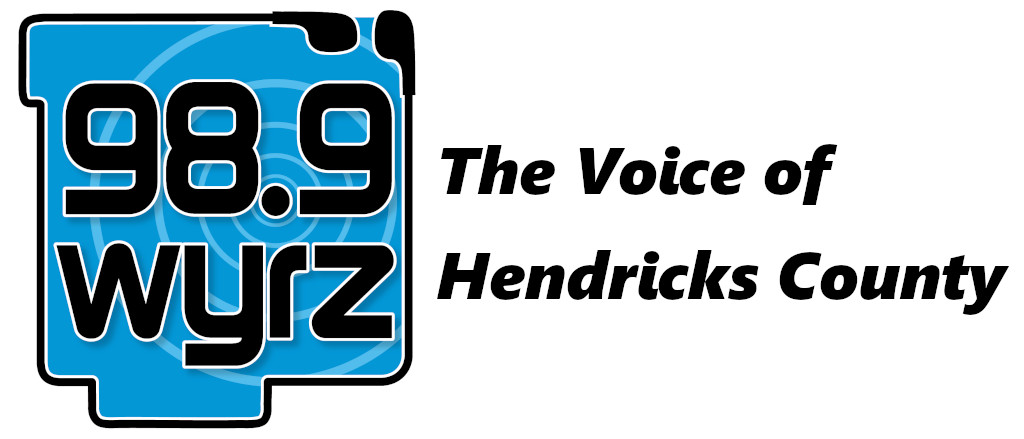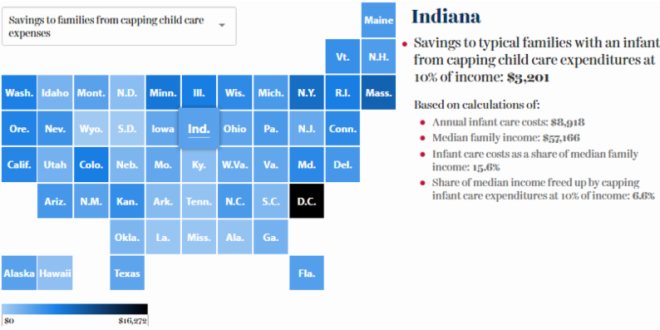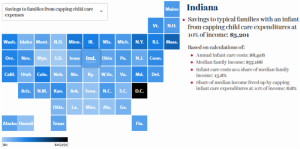Indianapolis, IN- In a new paper and accompanying fact sheets, the Economic Policy Institute details the high cost of child care in every state, and outlines the benefits of public investment in early childhood care and education (ECCE), to children, families, society, and the economy. In the new paper, It’s time for an ambitious national investment in America’s children, the authors propose investments including expanded public funding for home visits by trained nurses to help parents both before and after childbirth, subsidies to allow parents to afford high-quality child care, and the public provision of early childhood education, including high-quality pre-kindergarten education.
Annual child care costs are $8,918 for an Indiana family with an infant, and $6,760 for a family with a four-year-old. The Department of Health and Human Services currently defines child care as affordable if it costs 10 percent or less of a family’s income (and has recently proposed an even more ambitious measure of 7 percent). By the current 10 percent metric, only 483,909 or 29.2 percent of Hoosier families are able to afford infant care, and only 725,863 or 43.8 percent of Indiana families are able to afford care for a four-year-old.
“Investing in high-quality child care and early childhood education will have substantive, long-lasting benefits for children and for Indiana,” said Jessica Fraser, Program Manager of the Indiana Institute for Working Families. “Kids that have had these opportunities early in life go on to do better in school and eventually do better in the labor market. That’s why any effort to expand preschool in Indiana must also include an expansion of high-quality childcare, making sure children in low-income families have access to these opportunities, as well.”
Child care is one of the biggest expenses Hoosier families face. Infant care in Indiana costs $475 more than in-state tuition for 4-year public college.
Investments that capped child care costs at 10 percent of family income-for both a family with an infant and a family with an infant and a 4-year-old in full-year care-would save the median family with an infant in Indiana $3,201 a year. The median family with an infant and a four-year-old, meanwhile, would save $9,961 a year. Because the progressive nature of a cap on child care expenditures as a share of income, the savings would be even greater for families lower on the income scale.
Using an estimate taken from research indicating that decreasing child care costs by 1 percent would increase mothers’ labor force participation by 0.2 percent, the authors calculate that Indiana’s gross state product (GSP) would increase by 1.2 percent or $3,948,000 if these investments were made. Nationally, these gains to gross domestic product would also boost federal tax revenue by roughly $70 billion annually, providing a very large base of economic support to finance this ambitious investment in America’s children.
“Child care is extraordinarily expensive and yet child care workers are among the lowest paid workers in Indiana,” said Fraser. “An ambitious public investment in child care will not only make it more affordable for families, it will raise wages for workers and increase quality in the child care sector.”
The EPI paper reviews the patchwork of policies intended to make child care more affordable, including the child and dependent care tax credit, the employer-provided child care tax exclusion, and subsidies, such as the Child Care Development Fund. Unfortunately, the benefits of nonrefundable tax credits go mostly to well-off families, and subsidies for low-income families are inadequate and too-narrowly targeted. An ambitious, comprehensive national investment is essential to solving the child care crisis in America.
To access these materials visit:
Paper: http://www.epi.org/publication/its-time-for-an-ambitious-national-investment-in-americas-children/
Indiana fact sheet: http://www.epi.org/child-care-costs-in-the-united-states/#/IN






